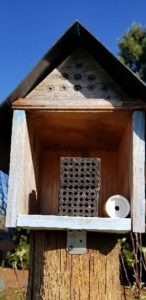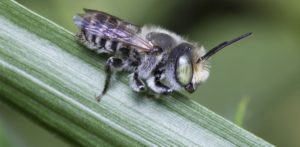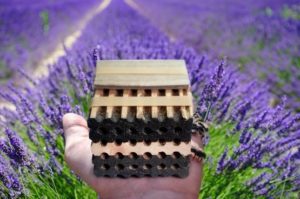Leafcutter Bees (The Garden Bee) are perfect pollinators of summer’s backyard gardens! A friendly, efficient, tireless pollinator. Grow more corn, tomatoes, cucumbers, peppers, squash, and peas with Leafcutter bees (The Garden Bee) that are 100 times more effective than honeybees.
Leafcutter bees have a short flying range of only 300 feet from their bee house, so you can be sure they will stay in your garden, work in your garden.
It is always good to plant a few edible flowers, like wild mustard, in your garden, for supplemental food, to sustain your bees, between the bloom of garden various vegetables. You can purchase wild mustard and a few others like an ox-eye daisy on our site.
Perfect Pollinators
Leafcutter bees are active in the warm summer months and they are perfect for pollinating corn, tomatoes, squash, melons, cucumbers, peas and peppers plus many other summer vegetables and fruits.
Leafcutter bees are extremely gentle. You can approach their bee house without fear of being stung. Even though leafcutter bees are solitary bees, they like to build their nests near one another.
Leafcutter Nesting Blocks
They do not create holes or damage structures to make holes, you must provide the nesting block with proper size holes. Leafcutter bees prefer nesting holes that are 6mm in diameter (1/4 inch).
Each female bee is solitary, and she chooses a nesting hole that she claims as her own. She may claim and fill a few different nesting holes, but she works on them one at a time.
If the summer season is long enough, the larva has time to develop quickly into an adult. These new adult bees are called second-generation bees and they go right back out to mate and start the cycle again. If second-generation bees emerge, you’ll see a large hole in the front flat end of the leaf cocoon. There can be more than one extra generation of bees and this makes the leafcutter bee’s pollination season longer, sometimes more than 6 weeks, it’s just another reason why they are great summer garden pollinators.
If you are interested in keeping leafcutter bees in your yard or garden, you can get started with very little time and money. You can set up your bee location in about 15 minutes. Set aside a little time to watch them when they emerge and start pollinating.
Leafcutter bees hibernate as larvae inside of their protective leafy cocoons and they need warm temperatures to develop into adult bees, this is called incubation.
To incubate your leafcutter cocoons, plan-ahead. If daytime temperature are reaching 70 degrees F, just place the Hatching Tube, your cocoons come in, next to your nesting blocks.

Timing
Time their emergence, with your Garden’s opening blooms.
Development is dependent upon temperature:
Adults emerge after about 20 days at 84 degrees F
Adults emerge after about 42 days at 70 degrees F
If you haven’t purchased your bees well ahead of time don’t worry, we put ten or twenty days on our cocoons before we send them out. You can also keep them in the house, to speed things up. Place the Hatching Tube in a warm location that may be close to, but not on, a heater vent. Every day in the house is like two days outside.
Bee larva inside your cocoons can’t regulate their temperatures so if it’s above 90F, bring them indoors and release adult bees as they emerge (in the early morning) or put them back when the temperature drops.
Keep cocoons out of the direct sun but facing the morning sun. The warmth will get them up and moving earlier, which will boost pollination.
Install the bee house on a wall, fence, or tree – bees do not like to sway in the wind.
Provide 1 nesting hole for each Leafcutter bee/cocoon, both male and female. Tuck the nesting block in the back of your house, as far as possible, to protect against wind and rain.
First-time leafcutter bee (Garden Bee) enthusiasts think that their bees flew away and are surprised a few days later by a leaf capped end. Give the bees at least two weeks to get settled.
Just as Mud is essential to Mason Bees, Leaves are Crucial to the Leafcutter bee: Leafcutter bees will leave your Garden if they can’t find their suitable leaves nearby.
Leafcutter bees like roses, Lilac bushes, hostas, dahlias, cherry trees, but best, is to plant a Pea plant next to your nest.
Bee activity usually stops in late August. This is when you will need to put in a little work. Collect and store the bees nesting blocks with the open ends up in a dry, secure building such as a garage or shed. The building does not have to be heated.
For instructions on winter storage and cleaning of leafcutter bee cocoons go to Winter Storage and Cleaning.


